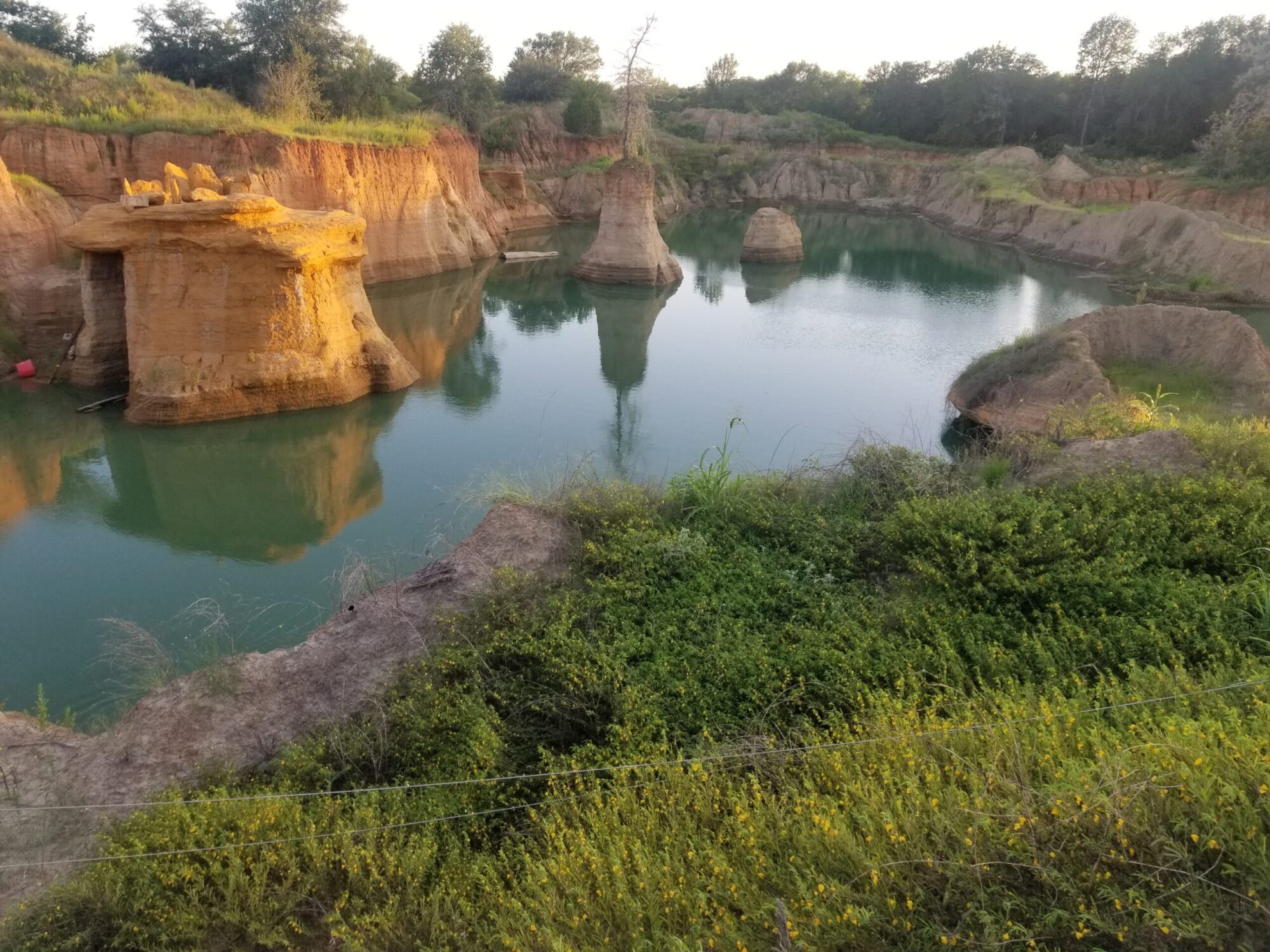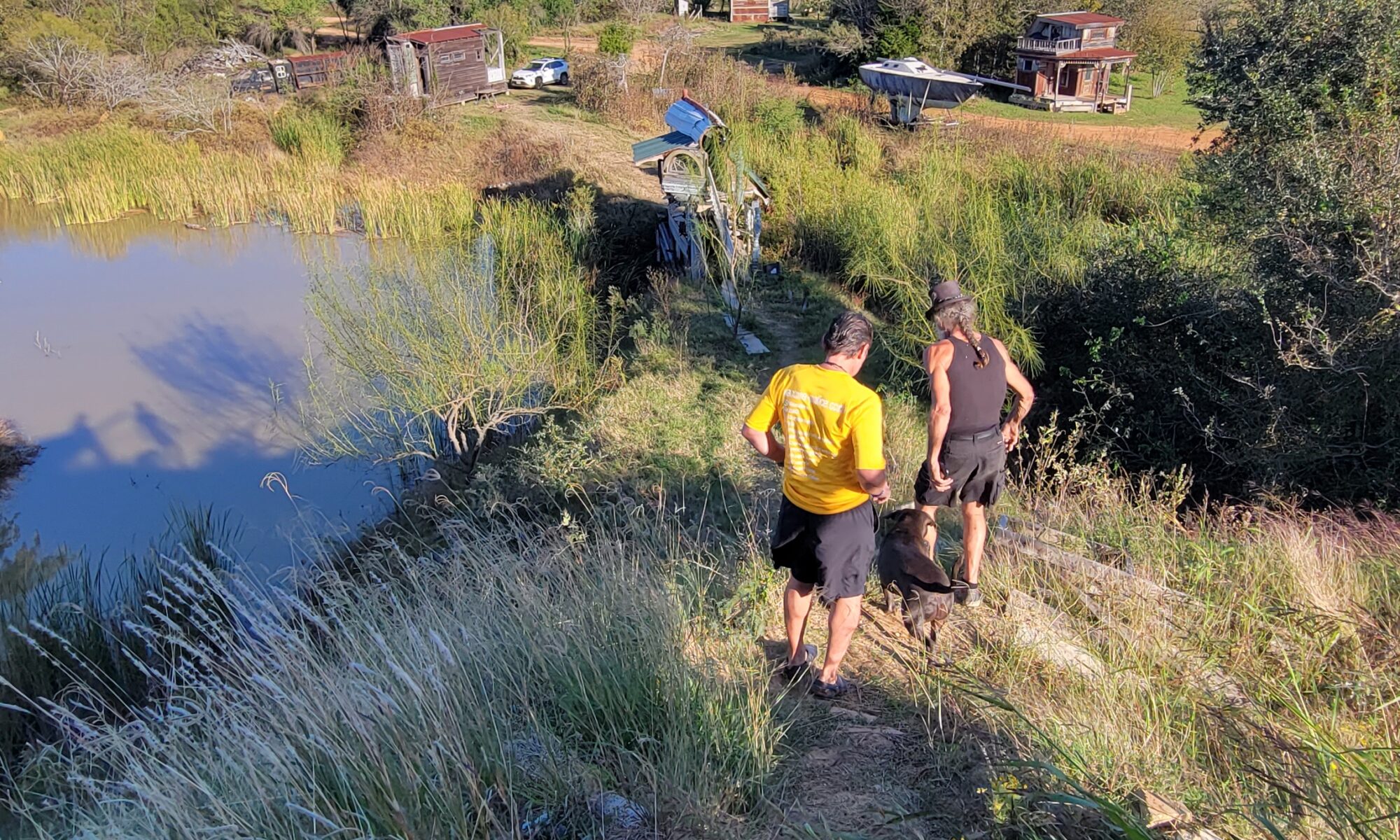Are you researching in hopes of finding a perfect intentional community without being part of the charter members who set up the ethos of Unity?
| Tiny Texas Houses19 hr ago6 |
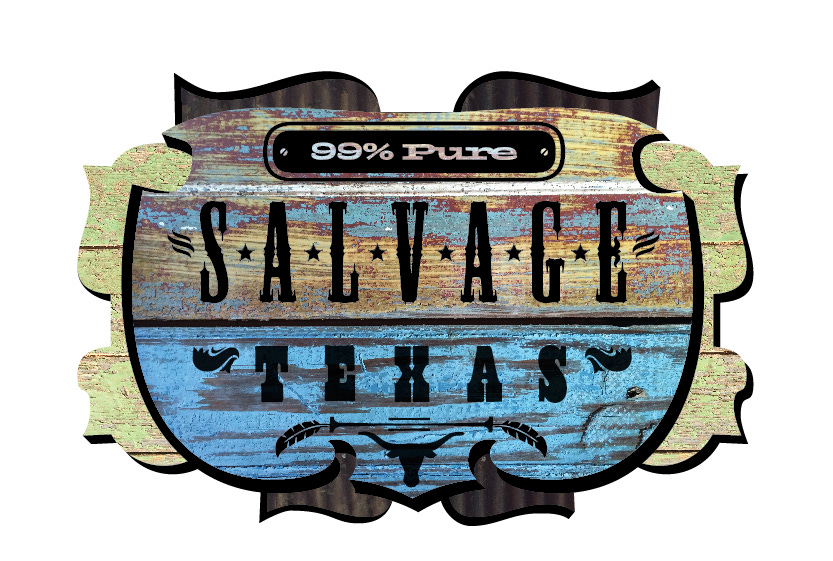
I started building Tiny Texas Houses in 2006 to show people just how big a Tiny House could feel since nearly no one thought such a small space could be comfortably habitable it seemed. In the twelve years before setting off on the quest of building 95% Pure Salvaged material tiny houses, I had successfully created and built Discovery Architectural Antiques into one of the largest businesses of its kind in the country. Thus, with a giant inventory and a realization that came with reading about the re-emergence of an appreciation for Tiny Houses and living spaces, I felt compelled to return to my creative side and show what could be built with nearly 95% Pure Salvage building materials.
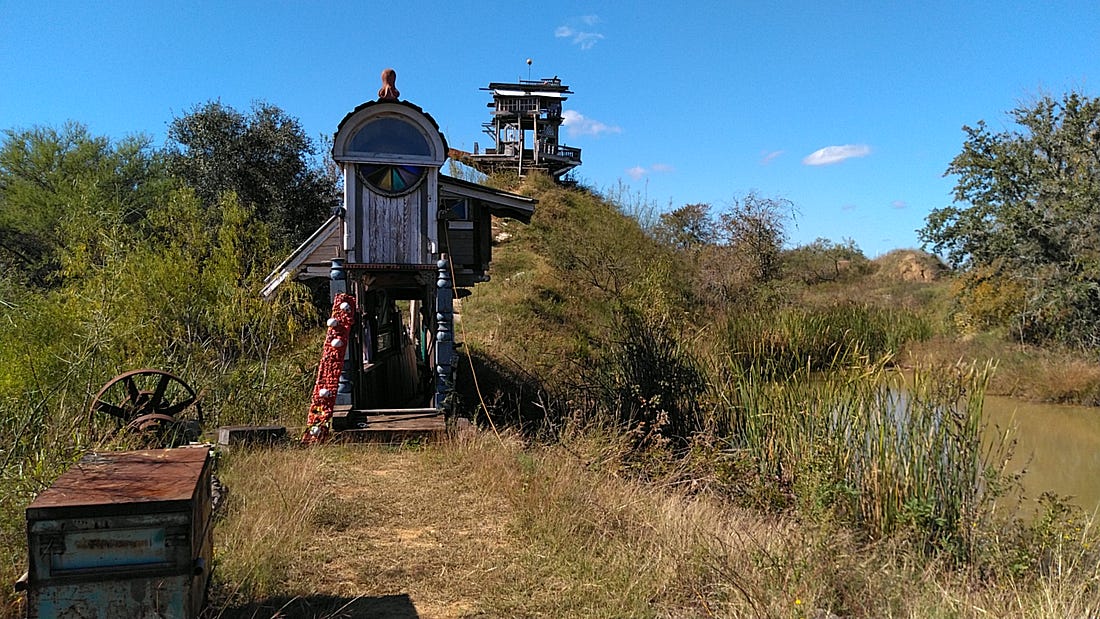
When one plans an entire village of like-minded people, the ultimate utopian goal as this cycle of intentional communities becomes a popular path in our culture once more. I say once more for the sake of Thoreau and Emerson for whom Walden Pond is named and the Covered Bridge Over Untroubled Waters that leads up Miracle Mountain to the Ship of Salvaged Dreams. For as long as they exist, the quantum story can be experienced by millions online, in-person, and through the people who will speak of it and share pictures around the world.

The early prototypes in each new intentional village will set the theme to a large degree as the land is bought, first houses built, and an ethos established as to the permaculture versus HOA that prevents individuality, gardens of food instead of grass, and many other cultural aspects of retirement or community living versus subdivisions where the people rarely interact. This seemed simple enough to describe as an issue to consider, but the many perils to how the community develops will be foretold by the ethos, religion, and politics of the people who set it up and reside there. So while there are many priorities some people will want, from guns to food stored away or the opposite, perhaps no devices that kill with (not likely in Texas or to survive if that SHFT moment comes).
It is not just the weather, or wars, besides the tornados that passed by like the one that tossed the first 6 houses I built, and in a very unfriendly way. In building houses, delivering them on road instead of build on site, along with the lessons on the ways to get materials to the sites of the buyers, led to much better construction and valuable techniques learned that I want to pass along. All of the wood, doors, windows, flooring, tubs, sinks, 95% of the hardware, and even the roofs are salvaged. Only the insulation, electricity, plumbing lines, and nails, or other elements need to be new in a Tiny Texas House. We can use Icynene foam insulation, high/low voltage wiring, solar/wind power, and black/gray water separation to create a new generation of housing designed to provide minimalist eco-conscious people the opportunity to create housing alternatives they can afford or even create themselves. Ultimately, the house itself, if built with poisonous outgassing chemicals from factory-built tiny houses that do not consider health as the highest priority, the box you choose to live in could be the thing that kills you or damages your children for life.

Group participation, living, and even subsistence can come from the Salvage Hunters who join with Salvage Miners to find and salvage the materials available for the Salvage Builders to create the next 4 generations of housing. There is much to be saved, in fact, gained, by building with quality materials that have already outgassed and cured decades ago, with little more than Tung Oil, Linseed Oil Paints, and other ancient formulas, it is possible to build simple, adapting to the materials, and create houses that will be affordable. The wood and materials can save costs, carbon wasted cutting down trees, transport, as well as bricks, glass, hardware, and more which could be the key to making this industry so viable at this time. People can share in the razing of houses and buildings, barns and stores to raise the houses, the new stores, and the ways to create a future without importing the parts, harvesting earth resources for new building materials, and thus save many of the best things from our past that our ancestors worked so hard to create for us.
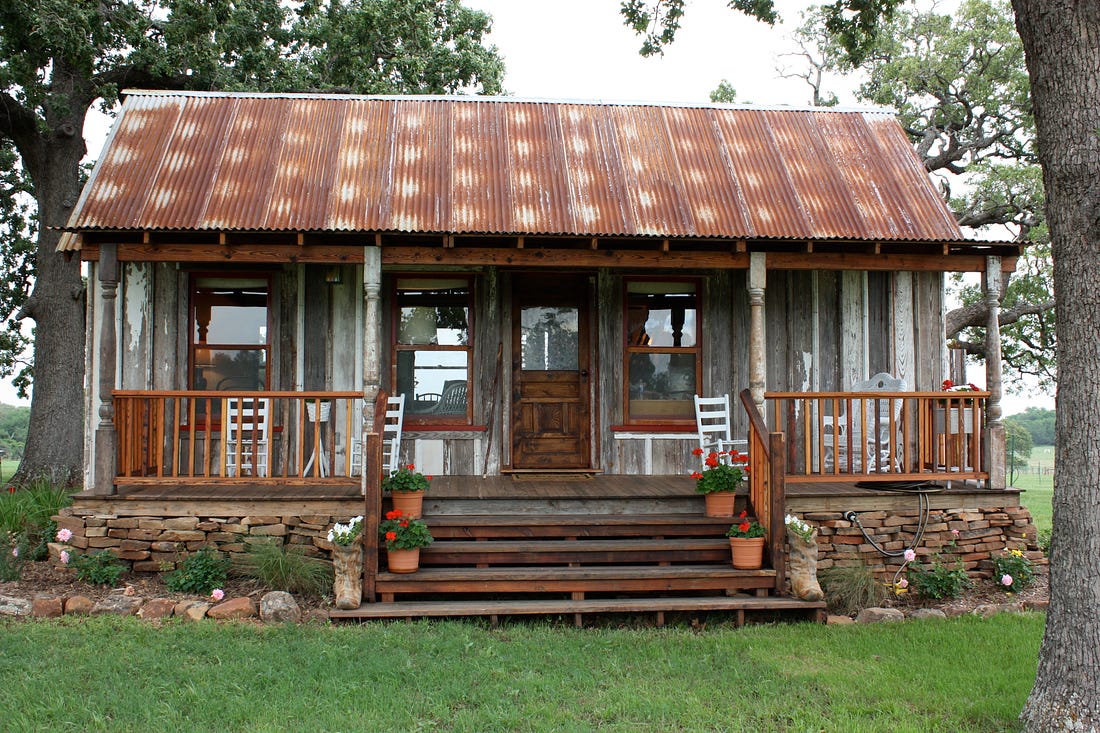
In the Tiny Texas Outpost and Village scenario, that can have a Non-profit mentor to coordinate getting large old buildings in areas that would benefit from the jobs and training skills that come with each of the new Outposts. We can do this for many if the right people choose to get involved with the transition from elders to the new generation that must imagine the future and act in such ways that it gets better. This contrasts just repeating the behavior that is now making pollution worse, waste is worse, and the ways to clean it up are not keeping up with its creation. Can it be done in such a way as to be popular instead of looked down upon? Yes.

While most clients who have bought our Tiny Texas Houses used them for extra space, some have used them to live full time and I believe, by the response, we have gotten, people are willing to live in them at the prices I am asking now, and more would if we could produce them more affordably. That too is possible if we can do the Salvage Mining and Salvage Building locally then the prices for the materials and transportation could be lower thus reducing the costs of Tiny Texas Houses dramatically. Furthermore, as I have learned by experience, having the materials come in, get processed, and move out quickly to become houses will substantially reduce the costs of warehousing, taxes, and labor. The benefits of a massive inventory are offset by the costs of holding them and the liability from loss due to fire.
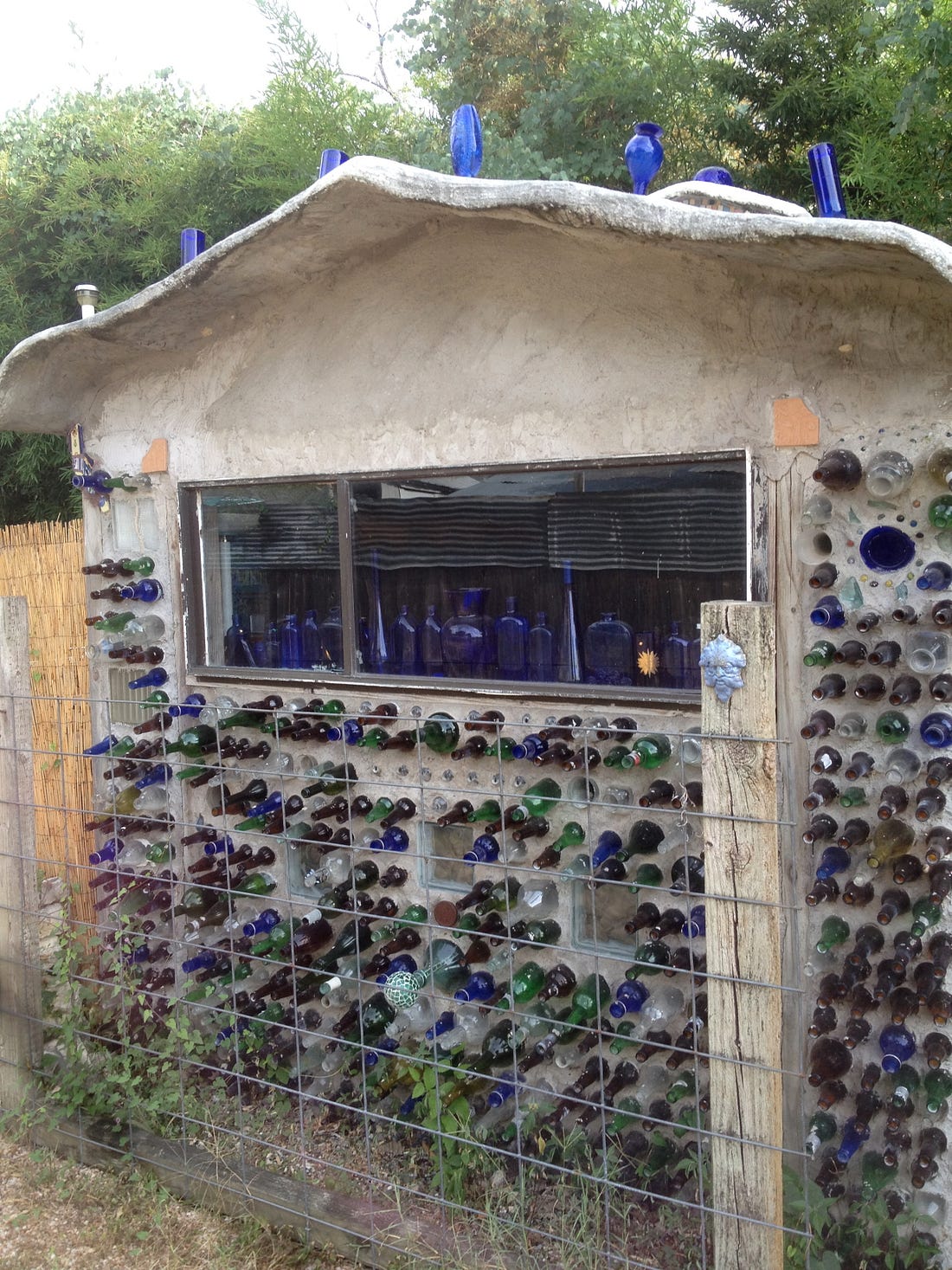
There will be ample income to allow everyone in the process to make a good living and fund a number of elements in the Tiny Texas Village and Outpost plans. The first structure that allows for building the other houses will enable the business of creation viable instead of depending entirely on volunteers. Making and selling things while building houses helps to create the income it will take to pay for the development and sustenance once the village is created on its way to becoming a community. Then the problem is who gets to live there and how many? Next, how do you feel about the cap and who says no to the many who want to come, the relatives, friends, and others who will want to crowd into small villages once they appear to be idyllic or times get really hard in the city and many are looking for a place to bail, not a community to contribute to in order to live there. Many want to be paid or enticed to come as if their mere presence is payment enough and few communities can afford many of that archetype.
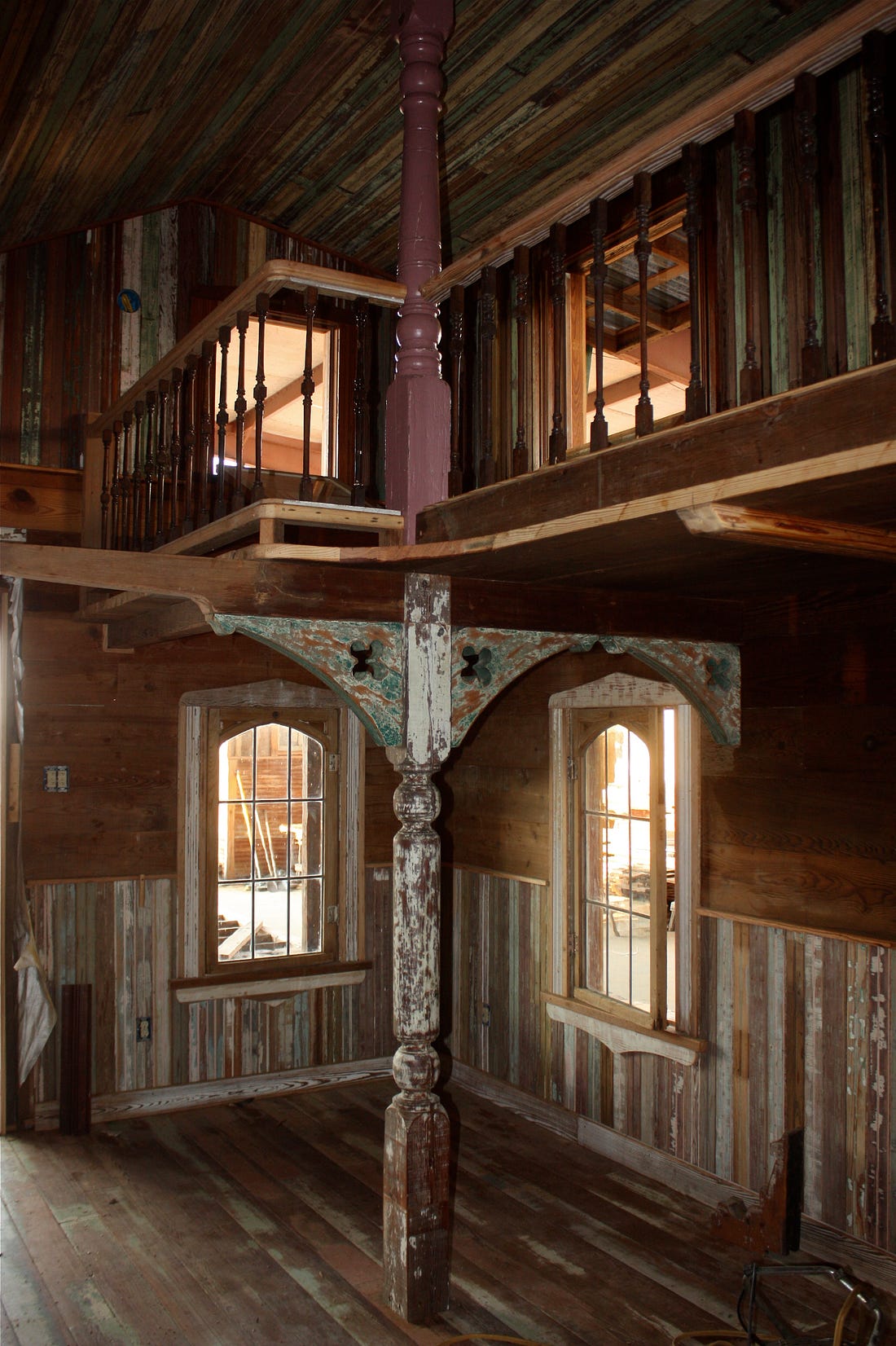
That is what the Tiny Texas House Concept is intended to facilitate. Depending on the size of a house, it can easily provide $15,000-$20,000 in labor and use $5,000-10,000 or less in materials to create a single house. There is a good living to be had for everyone involved in creating durable structures with unmatched longevity. Rather than promote “built-in obsolescence” which appears to have become the mantra in modern industry, we are focusing on the value of “Pure Salvage” Building that far exceeds any standard being used today, but the quality of our houses is not all that makes them such a good value. They are also cute, cozy, and portable can provide fresh air by design and cool with the windows open, stay warm with them closed.
Even more importantly, we can create like-minded communities designed to have the least amount of impact on the environment they live in. I am not saying that the materials and salvage building concept can not be applied to larger structures, it obviously can. But it is easier to teach with small examples than to do a big project that the common person can not relate to from the standpoint of solving their immediate needs. This solution can do exactly that and create a replicable system that could spread like wildfire across the country as more people look for alternatives to conventional housing and are willing to use their human energy to get what they want rather than waiting on the government to come to their aid.
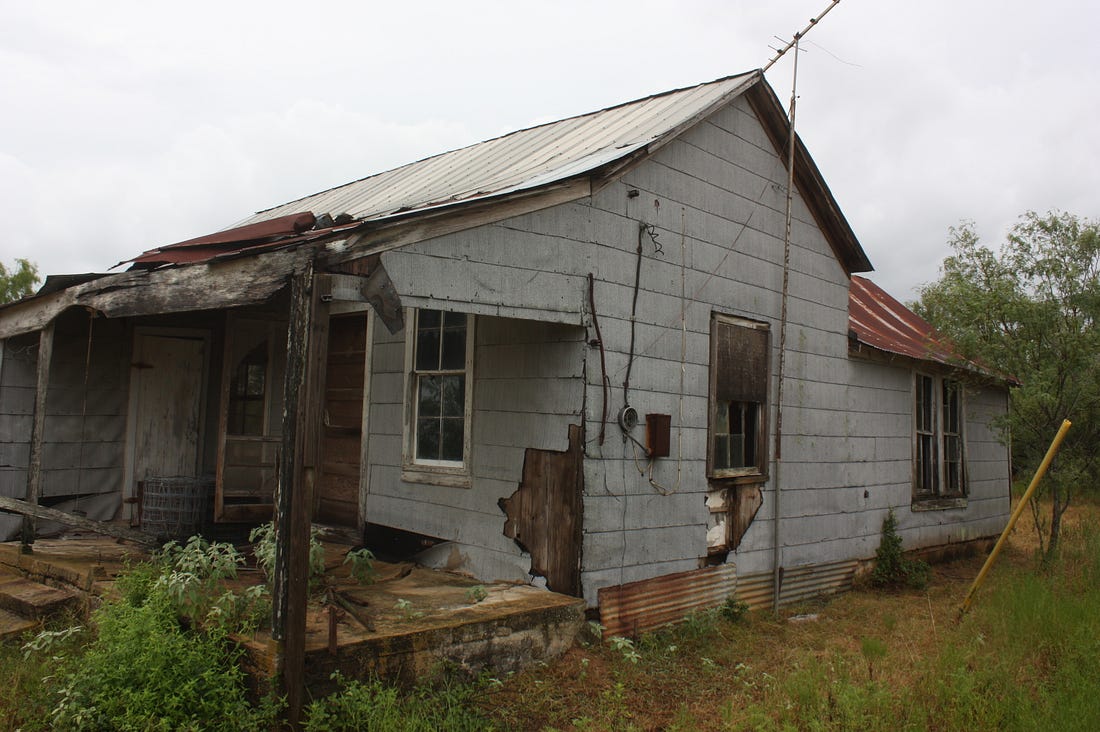
There is the potential for larger homes to become obsolete for great portions of the population as the economic crisis emerges as a factor in addition to rising food costs. It is only logical that if that occurs, people will be looking for solutions that would not have been considered feasible only two decades ago. While much of the building material resources have already been destroyed as waste, all is not lost. Enough wood, bricks, and salvage exist to house an entire generation now. Better still, the houses we build from salvage have the potential to last for a century or more and could form new energy-efficient housing communities.
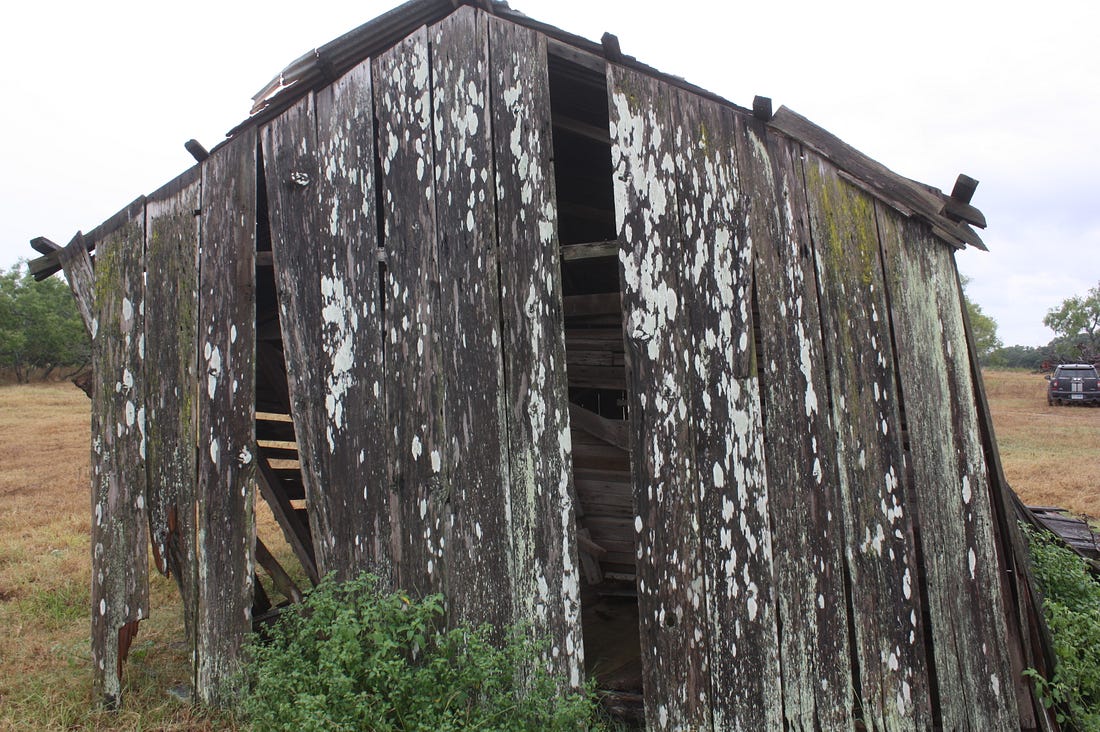
Each Tiny Texas House we build is either a prototype or an improvement on the last, never reaching perfection but seeking alternatives to the various issues that prevent us from creating universal answers. Our goal will be to continuously develop solutions to the many challenges that will arise as we convert people in different regions to our philosophy of Salvage Mining and Salvage Building. The movement toward Salvage Building and its facilitation through Salvage Hunters can spread quickly given the financial incentives, but more importantly, it can provide a million skilled jobs, training, and nearly instant results: proof of concept was Tiny Texas Houses as illustrated in this booklet.
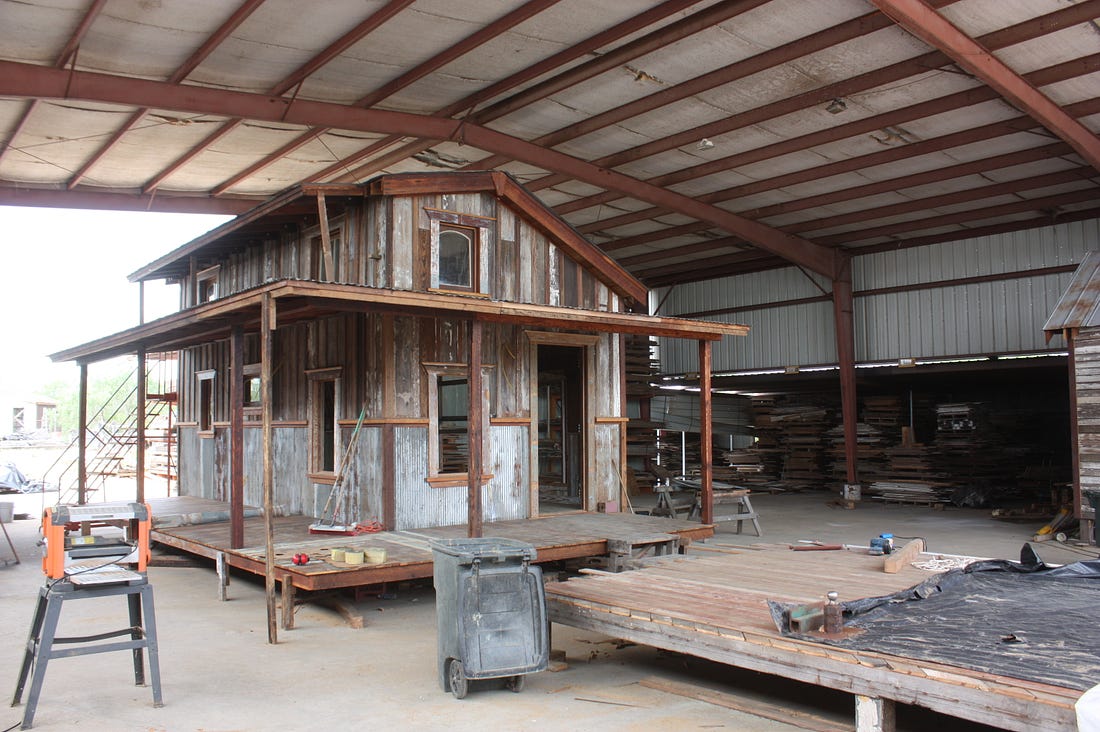
Regional villages will be able to consolidate processing, warehousing, and even packaging which will create even more training and jobs. It will cost the least to do it in rural areas near the cities where the land is cheaper and the cost to the warehouse will be less as the value of the buildings sitting empty is less. The incentives to the communities to participate are obvious given the potential for job creation and the elimination of nuisance houses as well as new housing that creates even more jobs.
I believe that the operations can be easily replicated every few hundred miles without saturation issues well into the next decade. Rarely are there solutions that can be applied so quickly and use pre-existing infrastructures left behind by industries that moved their labor costs overseas?
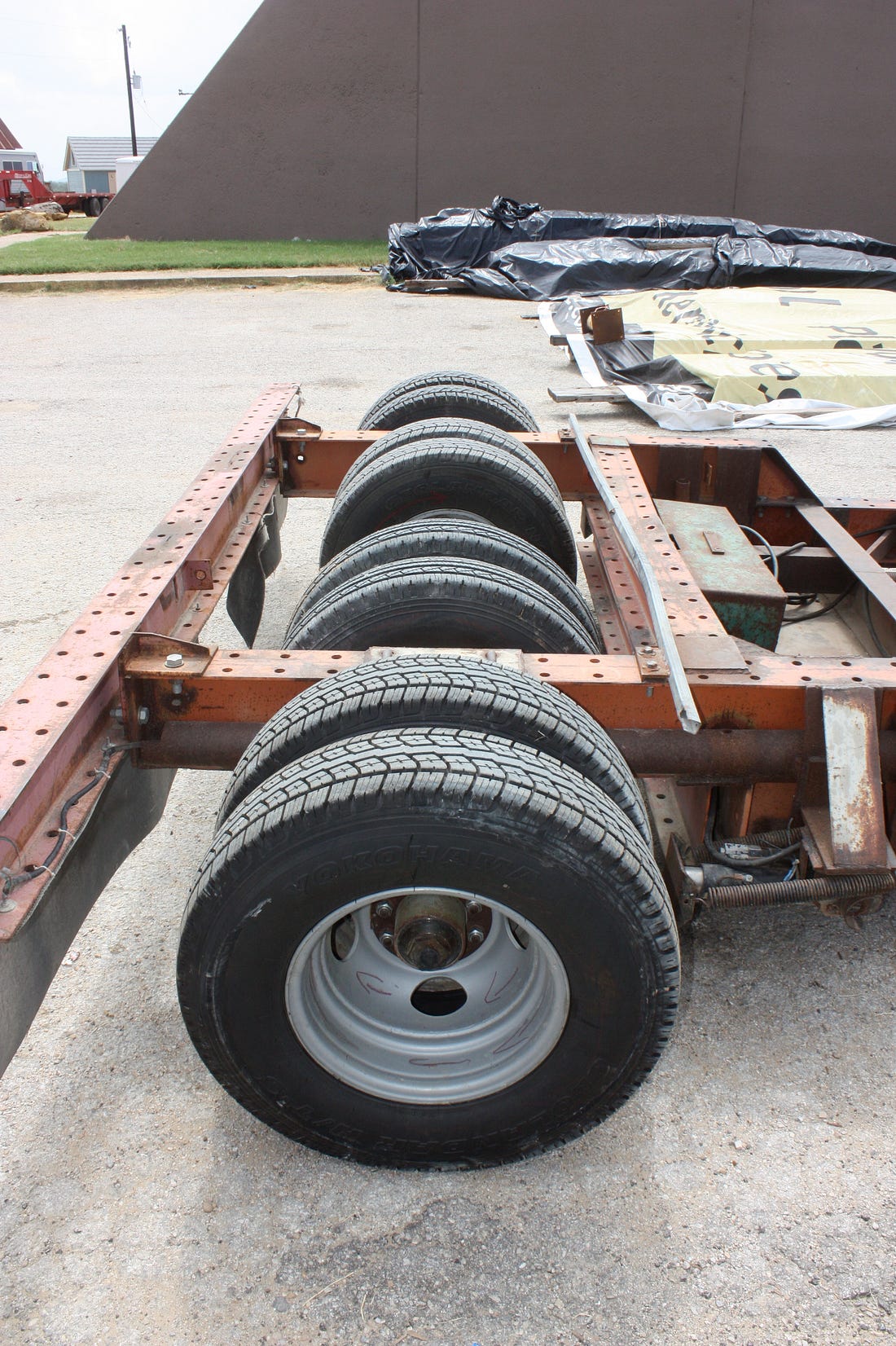
This American-grown resource can only be harvested by people who live in America and it will provide houses for the citizens as well as create a possible export industry. It could play a significant role in solving America’s needs for housing, jobs, and the revitalization of historically industrial communities around the country where the industries are gone and empty obsolete buildings or houses abound, presently awaiting demolition, not salvage. What we do not use in this country could be exported or warehoused for generations ahead. We stock oil reserves, why not this valuable resource, my invisible commodity.
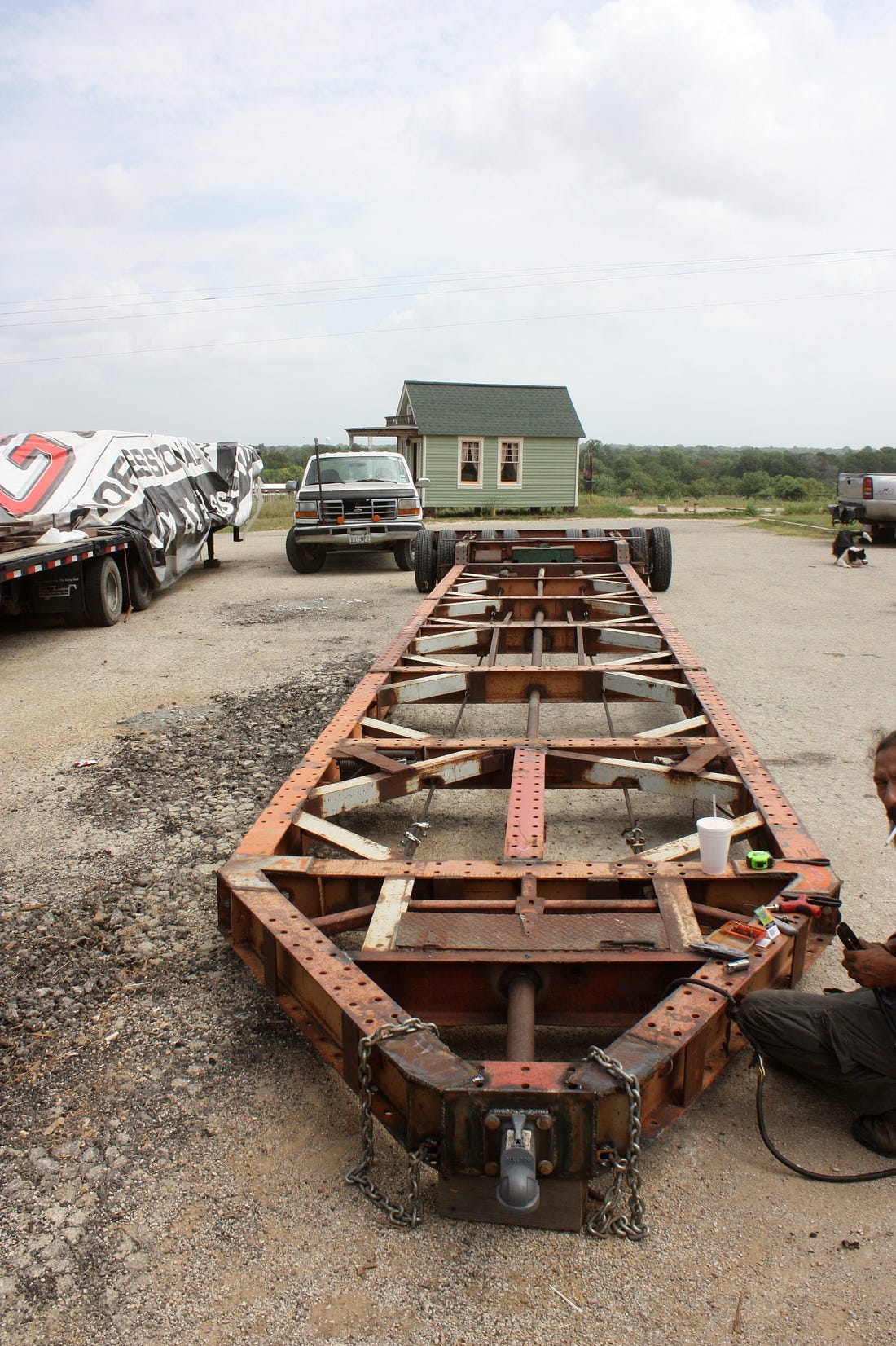
Each Tiny Texas House we build is an opportunity to create the building plans and options for the Tiny Texas House communities to use repeatedly in the future. No two houses will ever be identical, because adaptation is an essential element in the Salvage Building concept. It creates a sense of pride as well as individuality that is critical in a modern world if we are to maintain and express strong identities in a global society. I believe many people are ready to live with less in order to have more time to enjoy life rather than work under great stress. Many people are realizing they have too many things they don’t really need and live in big places they can no longer afford or desire.
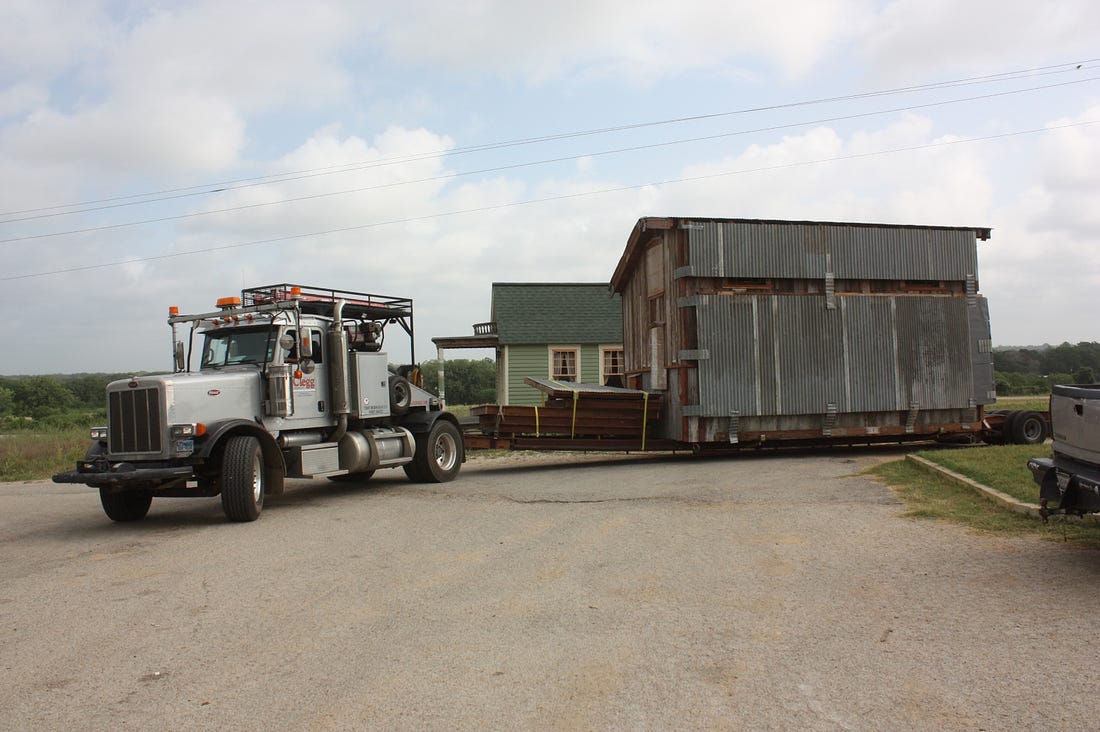
Some will choose the minimalist lifestyle because of a lack of alternatives, others with the desire to limit their carbon footprint and truly lead an eco-sensitive existence. Regardless of the motivations, it cannot hurt to have this sort of alternative housing for the poor, elderly, students, and everyone who likes the simplicity of the lifestyle. It is not what you have, but what you do with it that determines your legacy. It begins its new life with a pure environment that adds to life instead of compromising your immune system and taking away from your life.

Life seems shorter every year and knowing that stress kills us, some of us baby boomers are opting to give up many of the things we have accumulated. Without reservation, simplicity reduces stress and hopefully, we thus live longer healthier lives. Wasting life hours to pay the mortgage, taxes, insurance, maintenance, and fees to keep more house than you need wears after a few decades. Some fail and lose it all only to need the chance to do it all again on a Tiny Scale and find the simple happiness that security brings without the stress of going big.
The Tiny Texas Village
The concept of a Tiny Texas Village is simply one of bringing together small groups of like-minded people, preferably at least 10, on a space as small as an acre. Then it is possible to have enough participants to share and care for a common organic garden and take care of other community functions that come with group living. As with some other good plans that exist, I envision common houses for cooking, eating, and gathering other than the Tiny Texas Houses each person lives in. The Tiny Texas Inn could be the common cookhouse and meeting area.

We also have a Tiny Texas Chapel for spiritual meetings and even an old-fashioned one-room schoolhouse that would be great for homeschooling within the community. The idea behind many of my objectives is to create options for simpler lifestyles where people are willing to sacrifice space and things to free up their most valuable asset, time. We can create living spaces of all sizes using salvage materials so that people do not have to destroy the environment or give up so many of their life hours to pay for housing.
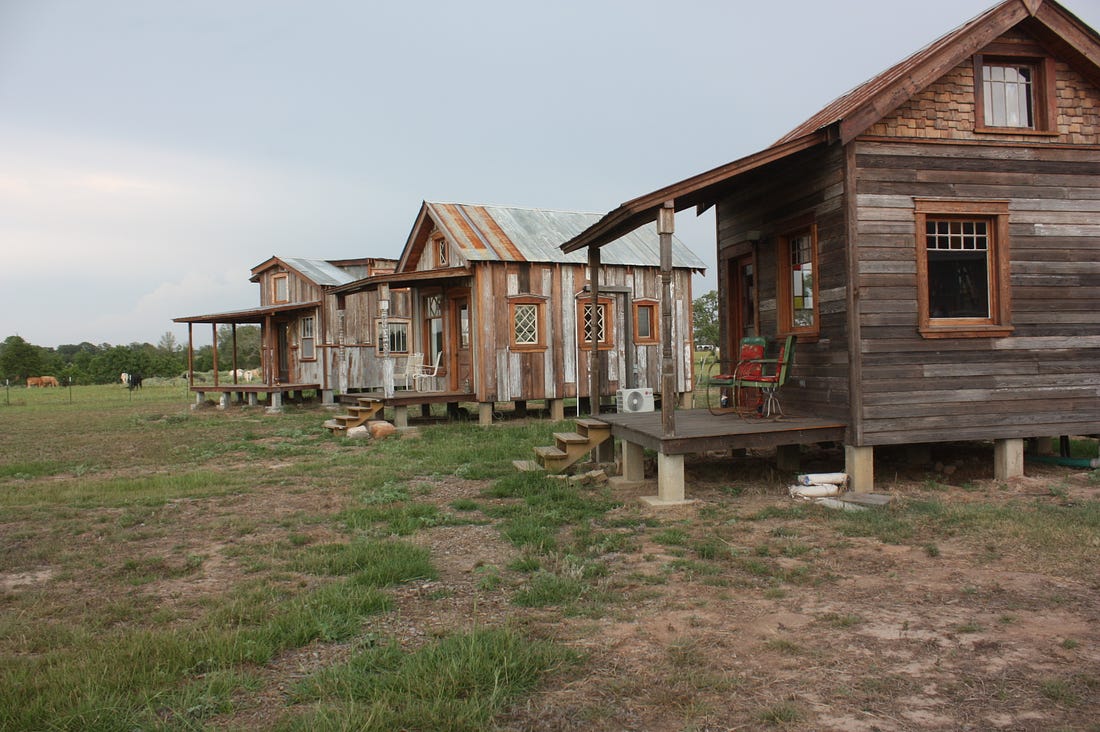
We can join Europe, Japan, and other societies where space is a luxury, not just to own, but also to heat and cool. In most other countries the easy-to-consume building materials and resources were used up centuries ago. They treasure their trees and water, while we are just waking from a long party where the resources were abundant and the price was hard for our society to comprehend until we nearly used them up. Now, as our society awakens to this problem, I hope that we can recognize the vast resources available in the form of salvageable building materials sitting in a place that is being thrown in the dump rather than being up-cycled and entirely re-used.
Given that 100-year-old building materials came from some of the best trees ever grown, or likely to be grown in this country, it is amazing that we will throw them away rather than cut them up to use again. We protect our tiny remaining Virgin forest with a vengeance yet let the product of the past logging of the rest of the Virgin Forests be thrown into the dump to rot. It is a rare tree that will ever grow to be hundreds of years old in our country again unless it is protected. Even now our last stands of Virgin forests are under siege by the lumber companies. Why not just re-harvest the incredible lumber made from the trees that have already been slaughtered?
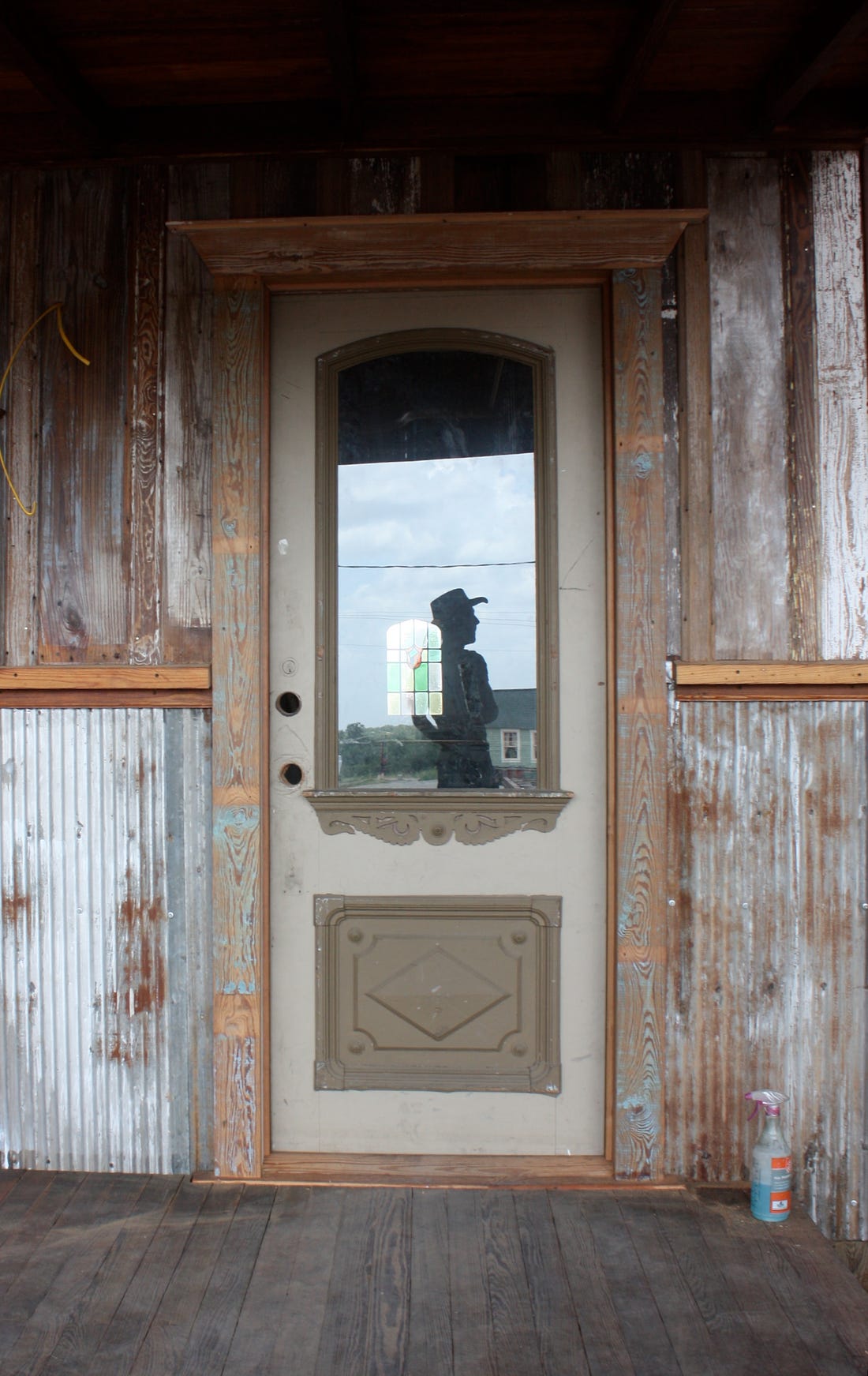
Every house we build without cutting down a tree makes a difference in the big picture. If people build smaller, less wood is needed, but if they use salvage, no trees need to be cut. An entire village can be built from wood without ever cutting a single tree down, and built to last for centuries. Therefore, with a smaller footprint for each house, more houses could go on each acre without crowding the acre from having trees, gardens, and other features that allow for nature to share the land. Families can live together without living under the same roof, thus allowing them to be in their own space, an essential part of independence and for many, happiness.
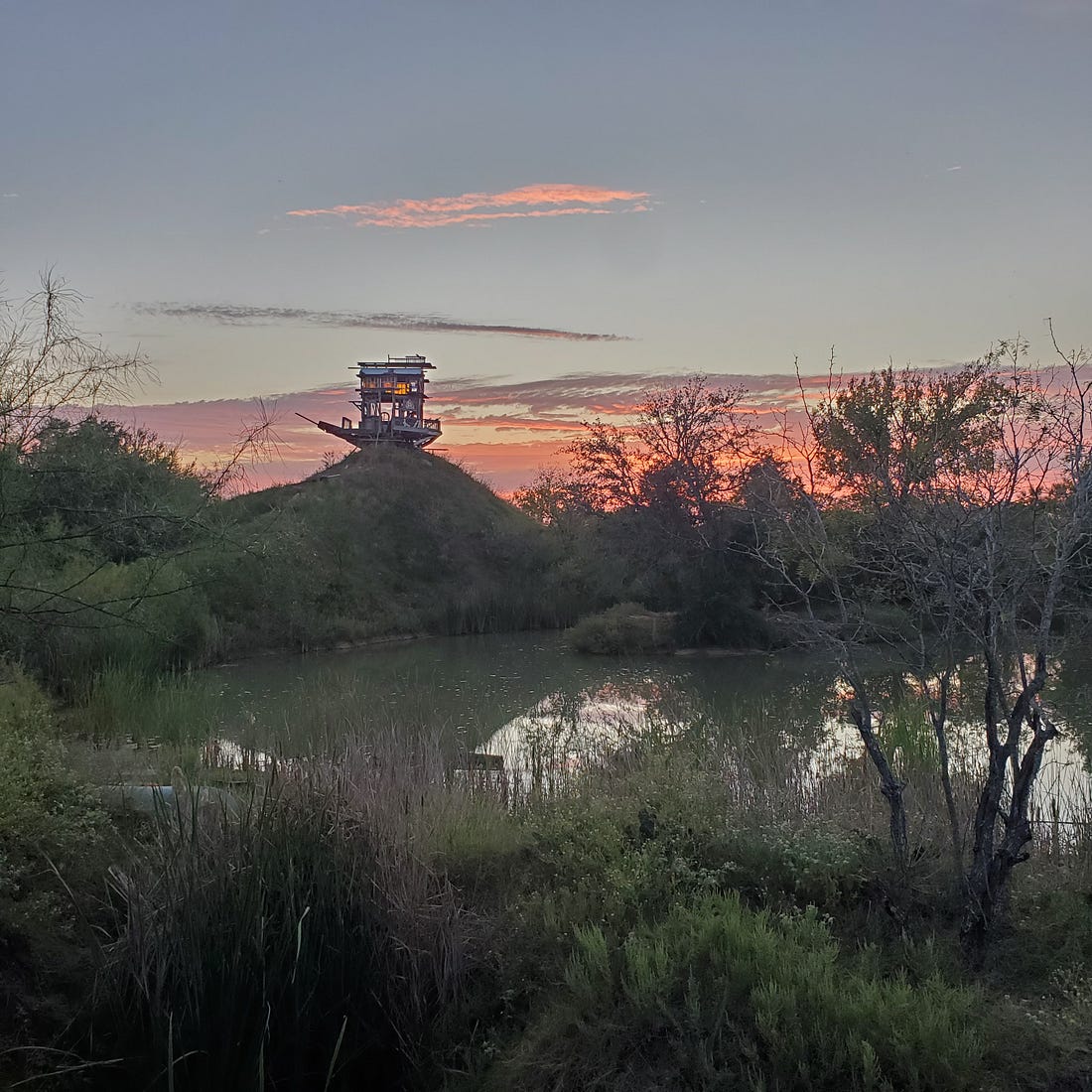
What stops this transition from one generation of housing supplying the materials for the next century of housing? Simply the perspectives of the people who can do the work, live in the houses and earn a living from making it all happen. The people become the spokes, parts in a big wheel that turns without the need for huge amounts of investment versus the huge returns to the society. This is an opportunity for the little guys to find empowerment through hard work and some vocational education, the sort that empowers people to put a house over their family’s head in hard times. This adheres to my belief in teaching men how to build a house from scraps so that their families will never need a home.
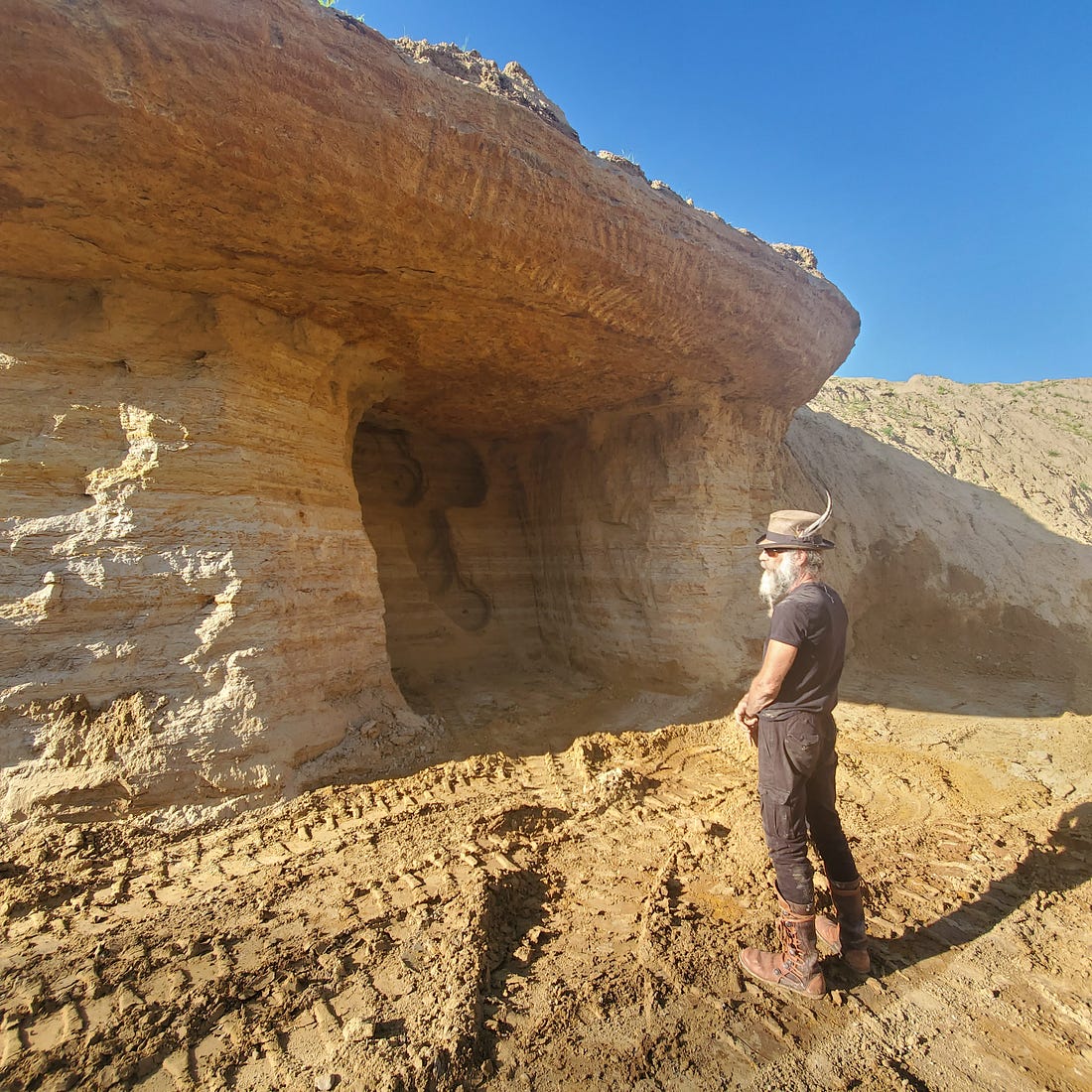
At this moment in our society, there is an abundance of building materials and a growing amount of unspent human energy in the form of the unemployed. Their greatest cost is housing and it is possible to create it out of nearly nothing more than human energy and knowledge.
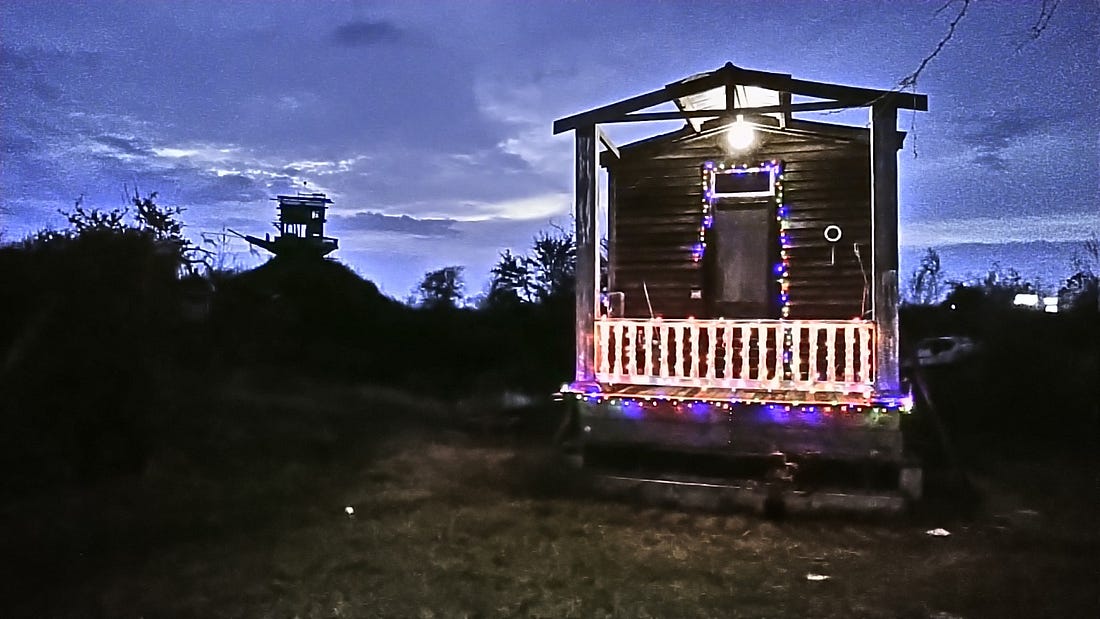
Why not teach them how to transform it into the answer to their problems, as well as for others looking for a new future in the new economy?
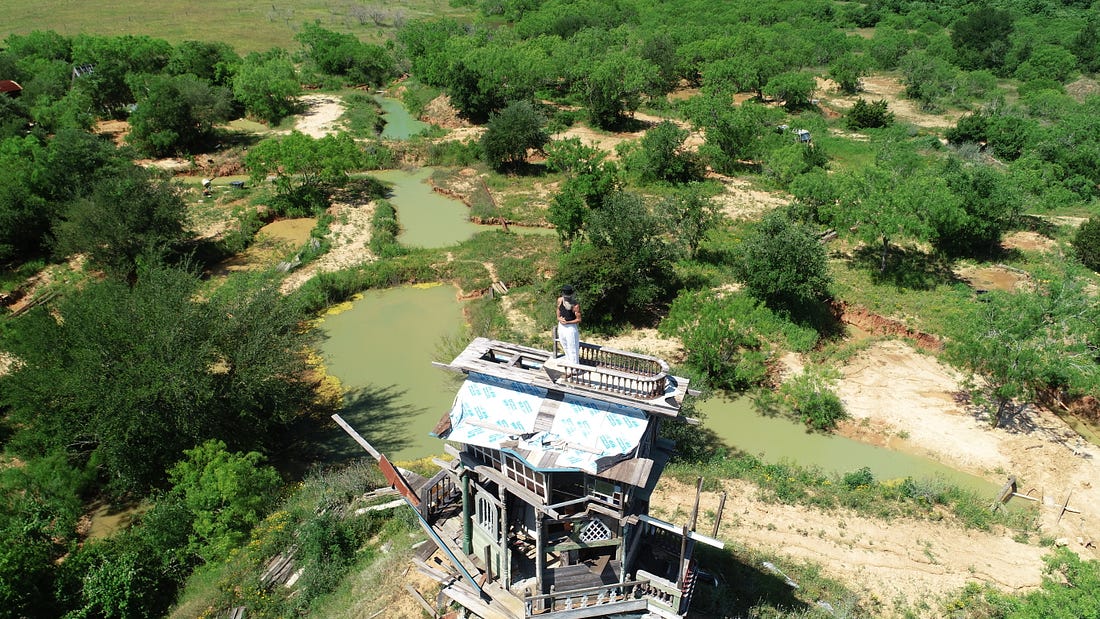
Tiny Texas Outposts for the future
The concept of a Tiny Texas Outpost is based simply on replicating what we are doing here every 200 to 300 miles. It is a simple matter of logic. Why transport materials a thousand miles when they can be used within a hundred. Likewise, why transport a Tiny Texas House a thousand miles if we can build it within a hundred miles of its destination? The response to Tiny Texas Houses has been good from every part of the nation. I have had inquiries from Florida to Maine and from Washington State to Canada. Clearly, there is lots of serious interest. The problem is the proximity of the demand if we are to remain conscious of the time and cost of transport. We must make that our goal or the proliferation of the concept of Tiny Texas Houses outside of Texas is doomed due to costs and logistics.
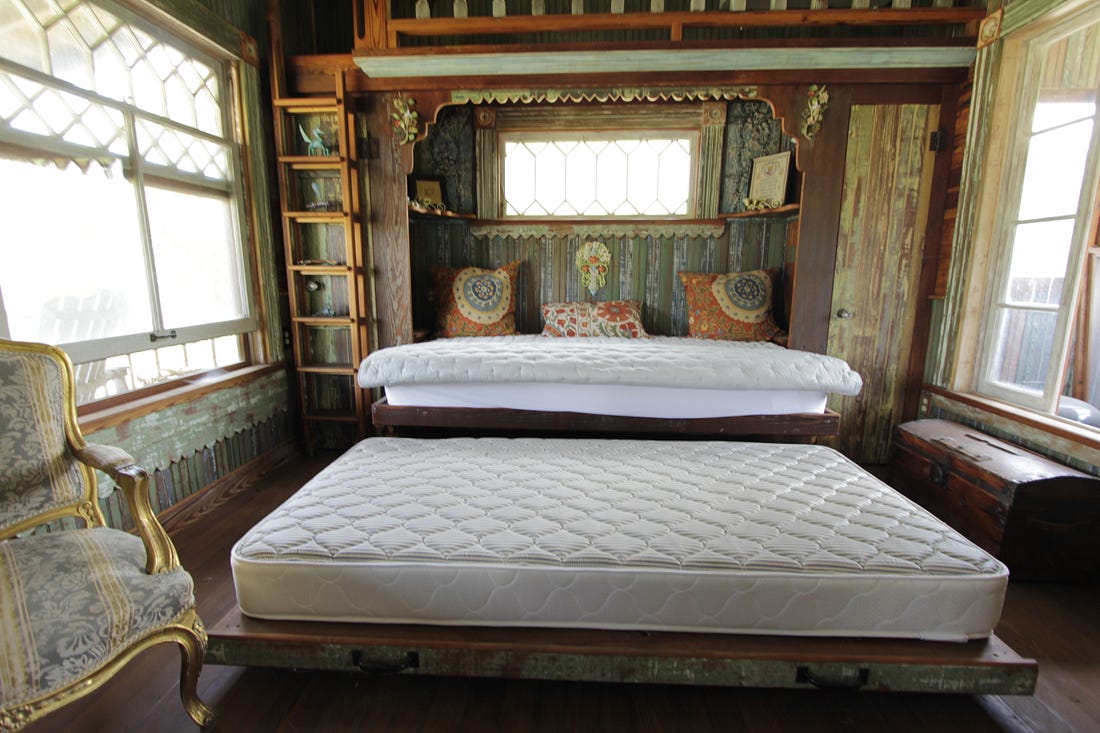
If we create a template for a Tiny Texas House (TTH) Outpost that includes several components, we can enable the rapid growth of the network. We need to include the warehouse and central processing facility, space for building a few houses inside, and for creating building material packages that can be shipped for assembly in remote places where transporting houses is not viable.
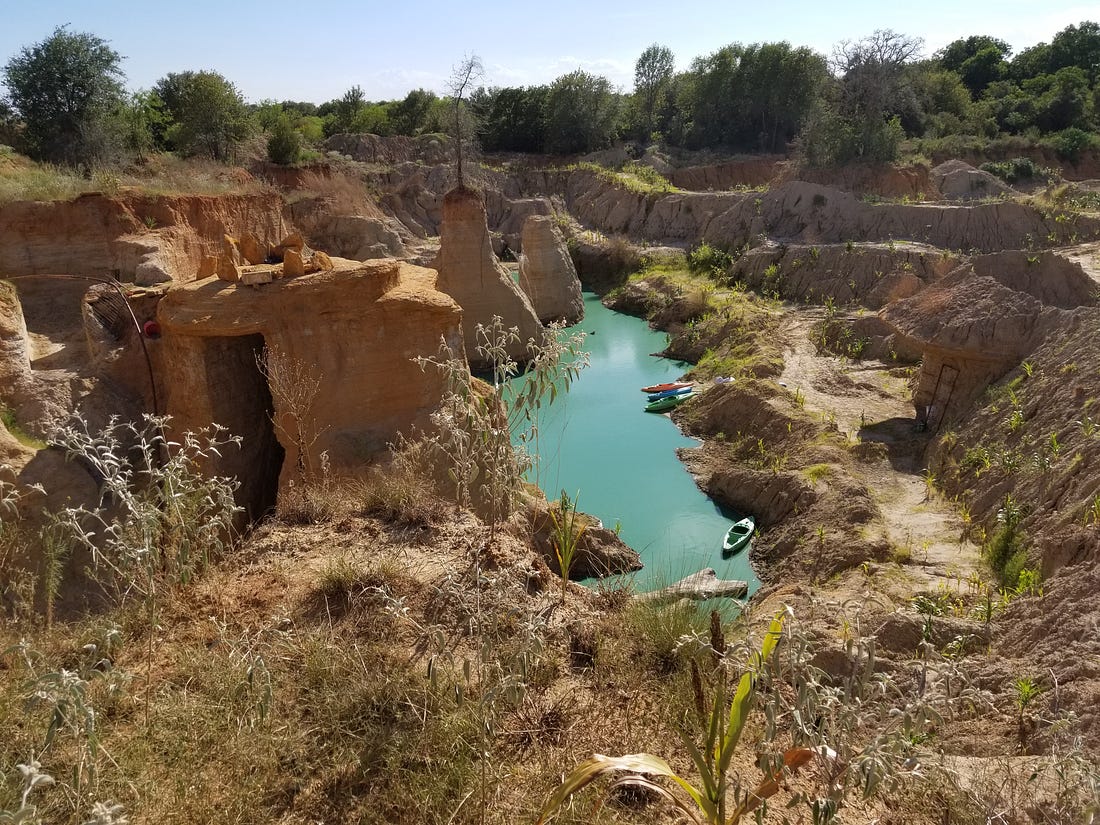
Another module will be the TTH Salvage and Farmers Market on the front of each TTH Outpost. This will create a venue for selling all of the other items that are found in the old houses from clothes, household goods, and furnishing to tubs, sinks, lighting, and other cosmetic goodies. We can replicate these TTH Outposts all around the country. It will also provide a place to sell organic veggies and fruits to fit in with the buy local concept for food. Likewise, there will surely be other products created from salvage or rebuilt to live again in new households.

Each Outpost is capable of providing a hundred related jobs or more when you factor in the Salvage Miners and Salvage Builders who will be working off-site and coming in just to drop off materials. The Salvage and Farmers Market will be operated by people who share the labor of the operations and are on-site mainly to service their spaces or put in their shared work hours on the floor.
Outposts are intended to create a communal entity and help reinforce the eco-lifestyle and ethics behind the Salvage Style of Green Living as well as providing support and solutions to the challenges that arise from developing each community and being self-employed. Each TTH Outpost could have a specialty to barter so as to perhaps include a Wood Mizer saw, a good helical head planer, a five-head molding machine, an industrial table saw, and a large industrial band saw. A co-op in one village could work with a smaller community that does not have that machinery.
We can use salvaged semi-trailers to make kilns to kill the larva in bug-infested wood. That with some other smaller tools lets people reprocess salvage into more valuable forms of building materials, like trim, and beaded boards or tongue and groove boards for the ceilings and floors. Again the equipment and the skilled workers are out there due to the loss of industry to offshore manufacturing, they just need the opportunity to work and make a living wage. Truckers could haul otherwise empty beds for bartering parts or labor to build a house with some of the materials they help haul around from one Outpost to another.
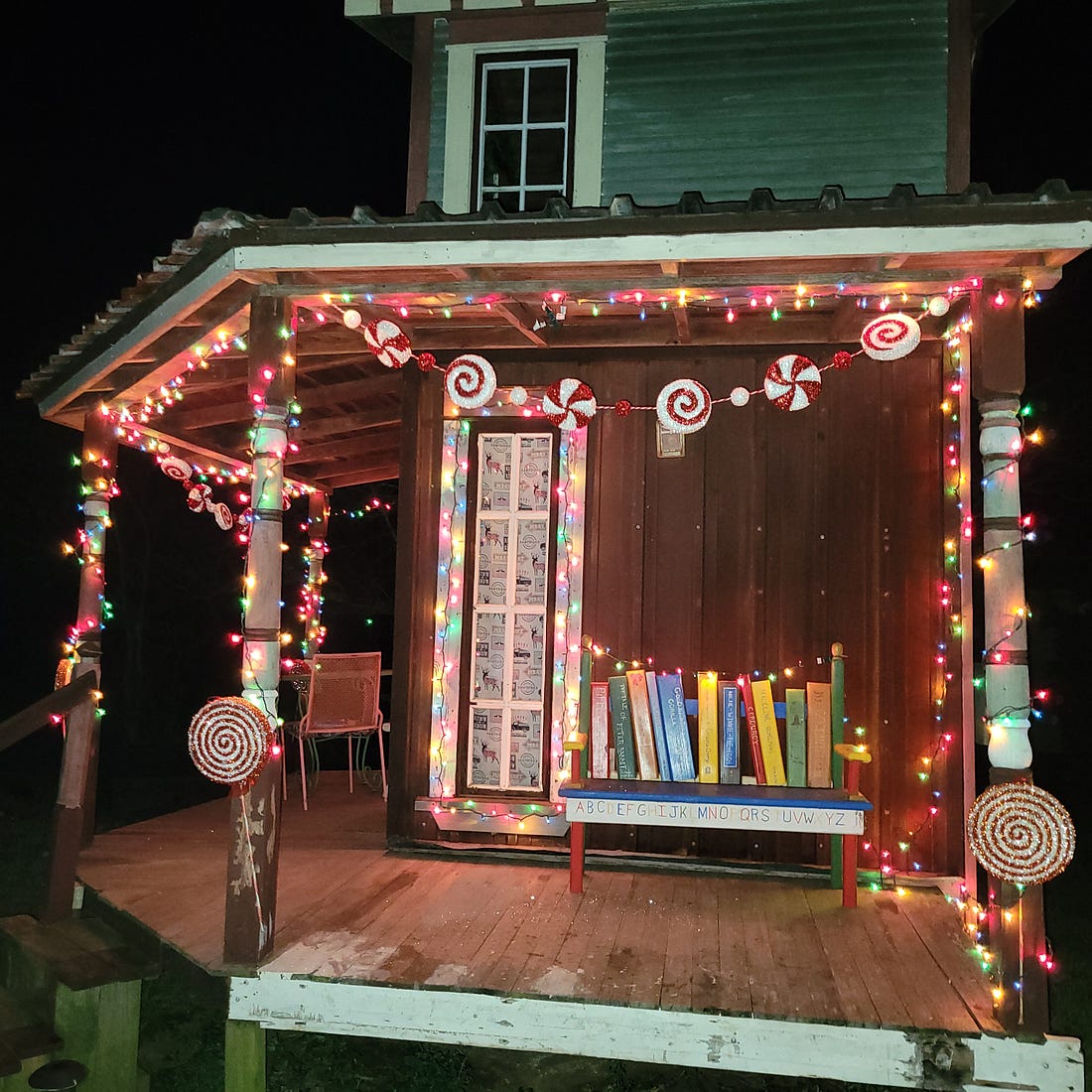
What this does is create a new core industry that must feed off of local labor, materials, and teach skills if it is to survive? It creates smaller housing that is more in line with the sustainable world that we want to create. It is a change in our thought processes that must take place if we are to regain our stature in the world as a society that cares about the future of the planet. It gives us a chance to prove through our actions that we are willing to make the sacrifices it takes to leave resources for the future rather than use them all up now. The ecology-minded need not look hard to see all of the advantages of working with Salvage.
This is a paradigm shift in how we think about Salvage can give us the ability to change the way we build homes for the next generation. We offer salvation of all sorts for the unemployed, the homeless, and the large families that want to live near each other but not under the same roof and want to do so in an environmentally sound way. Salvage is an old form of eco-consciousness that came from honoring what God created by treating it with respect, using only what we need rather than wasting it all. If we as a society can make the transition from waste to salvage consciousness then we should be able to turn what is now considered to be trash into new careers, housing, and a whole new world of eco-conscious living, perspectives, and opportunity, not just jobs.
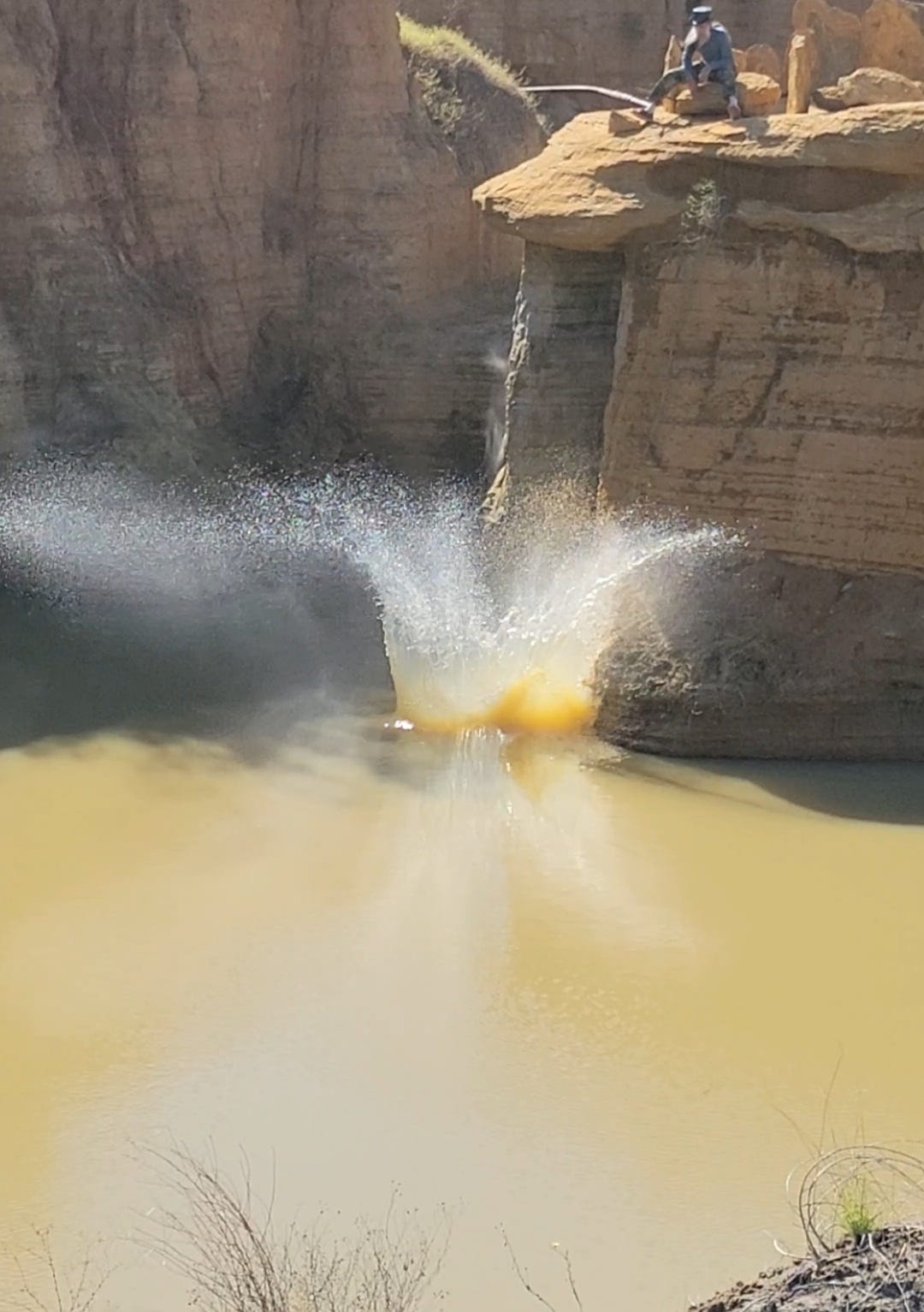
I believe there are enough people out there who believe this is possible and they are willing to live together, form new villages and communities centered around this objective. The rewards fall in all directions and the cost to the planet and society is negligible. The villages will develop barter systems and network with others around the country to move materials and talent to where it is needed most. Housing can become a new engine to unite people under a common goal that benefits all who get involved in one way or another. The beauty of this whole vision is that it can all be funded, fueled, and supplied with what most people in our country think of as trash.
Tiny Texas Houses modules for the Future

I can create small enough housing modules to ship anywhere in the world, or break the house down into walls that can fit into a container and be reassembled anywhere we can reach with the container and a crane. Once we prove that and the cost-effectiveness of the idea, we will be able to ship to markets that will appreciate the quality of the wood and craftsmanship and pay well for it. That market is our retail target since the high-end prices would help fund the growth of Tiny Texas House’s, Outposts, and Villages. The media attention to our finest creations and the pictures of what is possible will be what inspires the public interest and opens their eyes to what they could do if they take the opportunity and run with it. The great part is that people do see the possibilities and many are interested in the transition to smaller houses already.
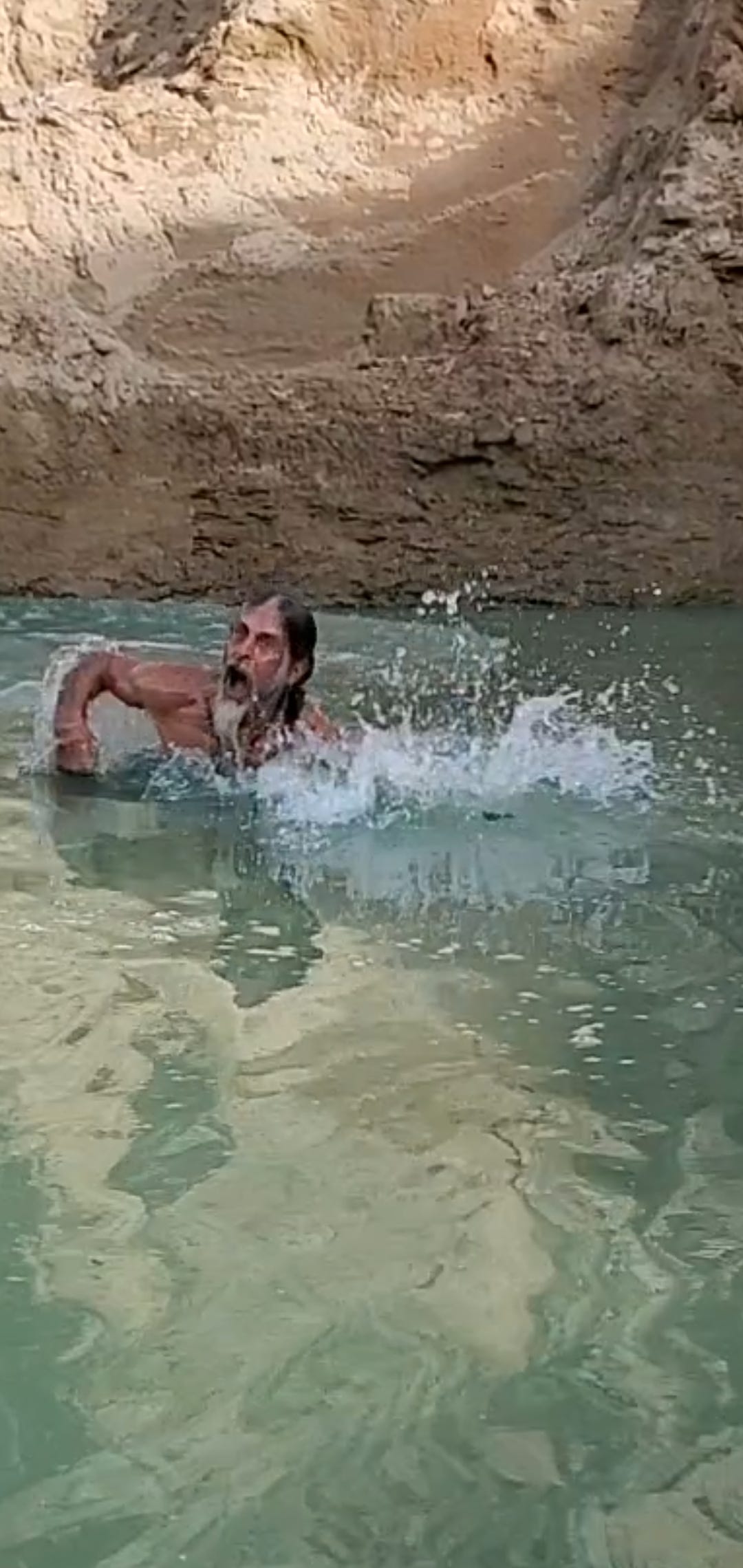
I want to teach the principles of Sustainable Salvage Building techniques that will create multi-tiered solutions to multiple problems facing our country and society. These in turn fit into the goals of global movements that target the same end, low eco-cost housing at affordable prices. On a global scale, our country has more to salvage due to our wasteful ways over the last two centuries. We’ve developed the throwaway perspectives to their zenith over the last 50 years as we dismantled the remnants of our industrial revolution and sublimated America’s pride in craftsmanship. We have replaced them with a Wal-Mart attitude of cheap, fast, and disposable. More than most other countries, the United States should set the example for transitioning to eco-minded living by leading the charge toward converting salvage into housing and reducing waste.
How does this help change the world starting locally?
This Green Fueled Salvage Revolution will create jobs to fill those left behind as the Industrial and Manufacturing Revolutions were moved overseas. This provides immediate self-funded solutions to other significant problems within our society that smaller communities could help solve. Vocational training is in short supply but will be needed to salvage or build since much of the future unemployed will have no vocational skills as they leave the floundering service industries like retail, restaurants, and hotels. Likewise, a re-orientation of people’s perspectives on housing needs and the reduction of living space will come as a likely consequence of the consumer credit crash and the time it will take to recover, if the system ever does, from the accelerating credit collapse already an inevitable event in the next couple of years. Many people will never want to be in debt again, like those after the Last Great Depression. For them, as with many of the baby boomer’s grandparents, a small house is all they will ever want or need.

Once the solutions are proven to not only be possible, but teachable and easily repeatable, the entrepreneurial spirit of this country will take the opportunity and thrive on it. I believe this to be especially true in times when they will be eager for real-life alternatives to their everyday problems. The proof is in the past when the New Deal public works projects gave people hope in the worst of times and thus the belief that better times were coming. This can be even more effective as I believe this movement can change our focus to empowering people to take control of their lives rather than depend on the government to pay for the solutions.
The TTH Village Concept and TTH Outpost scenarios are describing ideal self-sustaining engines that should not need a great deal of capitalization before reaching profitability. More importantly, if done correctly, with the common training, philosophy, and realistic goals, there will come with it a social bonding amongst those who participate. For many, there will be great satisfaction from being part of a big family or movement. For some, the experience of living in a Tiny Texas House will be nearly spiritual as a willingly made sacrifice with a promise of salvation for the damage we have each contributed to by living large in a modern world.

The corporate donations to the Salvage Foundation, a non-profit I have created (Never utilized and shut down… just paid for it all personally instead), as well as the individual donations from around the country (never came in) will be dispatched to help educate and train the regional Salvage Hunters and Salvage Miners. This is crucial to facilitating salvaging operations as well as training people to build Tiny Houses out of salvage. This network of certified TTH Salvage Miners, TTH Salvage Builders, and TTH Salvage Hunters will create an insurable, bonded group that can tackle big projects in unison or small projects on their own. (This should be noted, was written originally in 2014)
Given uniform training and methods, these independent teams can work together like ants when called upon to dismantle huge projects with uniform methodologies. They will share common ideas about the value of salvage and be motivated to work together and adapt to whatever it will take to tackle any salvage challenge. The fact that there will be a highly visible Non-Profit to accept and dispatch projects all over the country means that a clearinghouse can be created to move valuable materials where they are needed the most. This transport only needs to happen if there is a known demand before materials are shipped since the goal is always to transport the shortest distance possible.
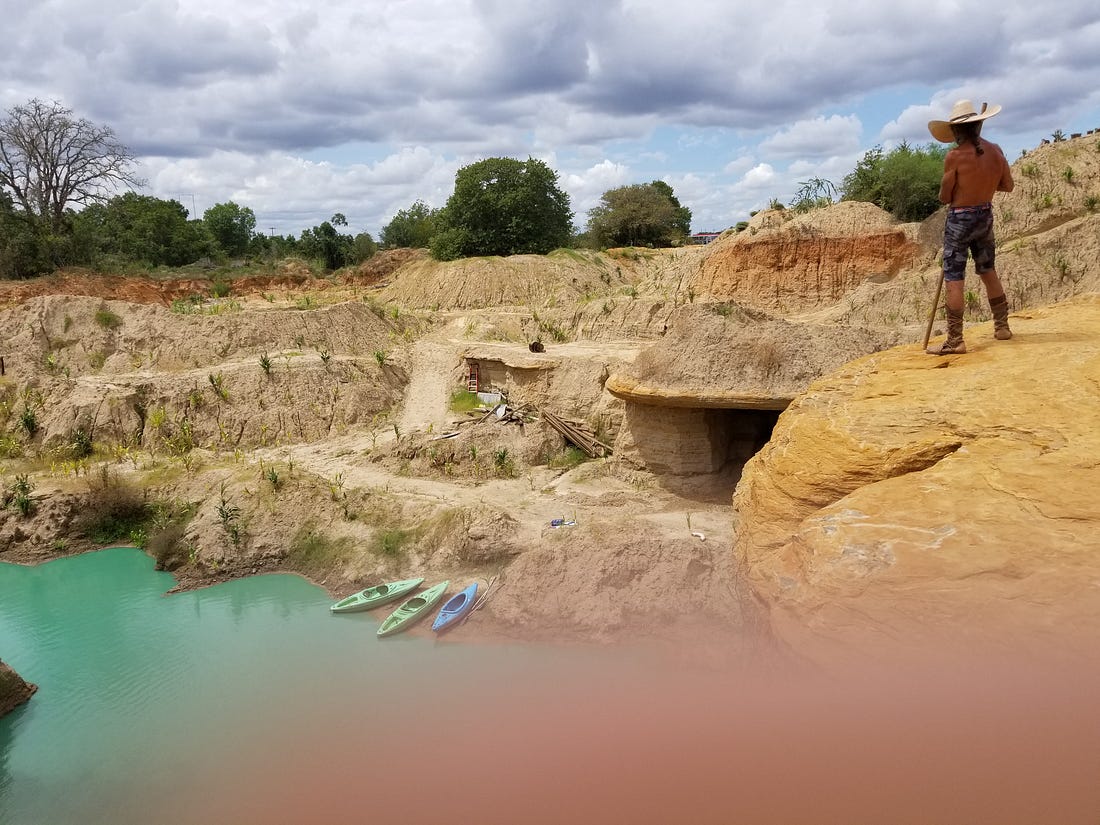
For this reason, there will be many benefits to linking up all of the Outposts and a need for tracking inventory that passes through all of the regional Outposts. Thus the best stuff can get to where it will have the most value and be tracked in order to ensure the Salvage Hunters can monitor the harvests from their projects and what happens to them once they are put into the warehouses.
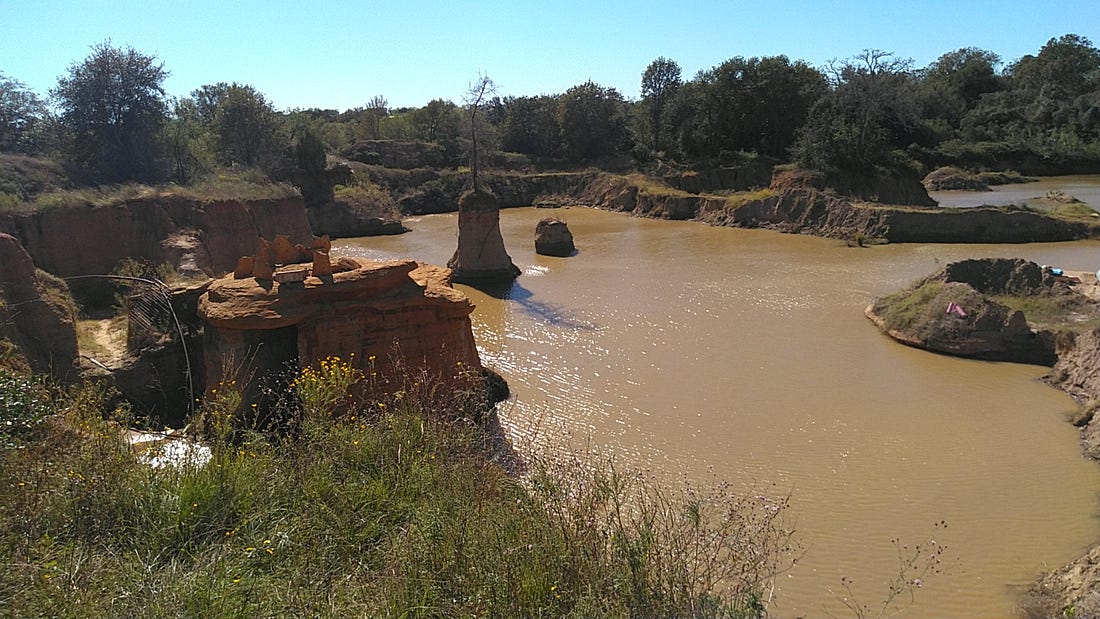
The secret of this whole concept’s success is that the inventory moves through the warehouses quickly to minimize overhead and to create low-cost housing or retail sales. The margin of profit on the houses and materials sold through the Outposts is what will fund the financing and building houses for all of those who are participating in the process. Bartering of skills and services, as well as the food and other community functions, can be coordinated through each TTH Outpost. The Salvage and Farmers Market at each outpost will be run by the vendors as part of the bigger co-op perspective that could be instilled into each Outpost and help bond people together.
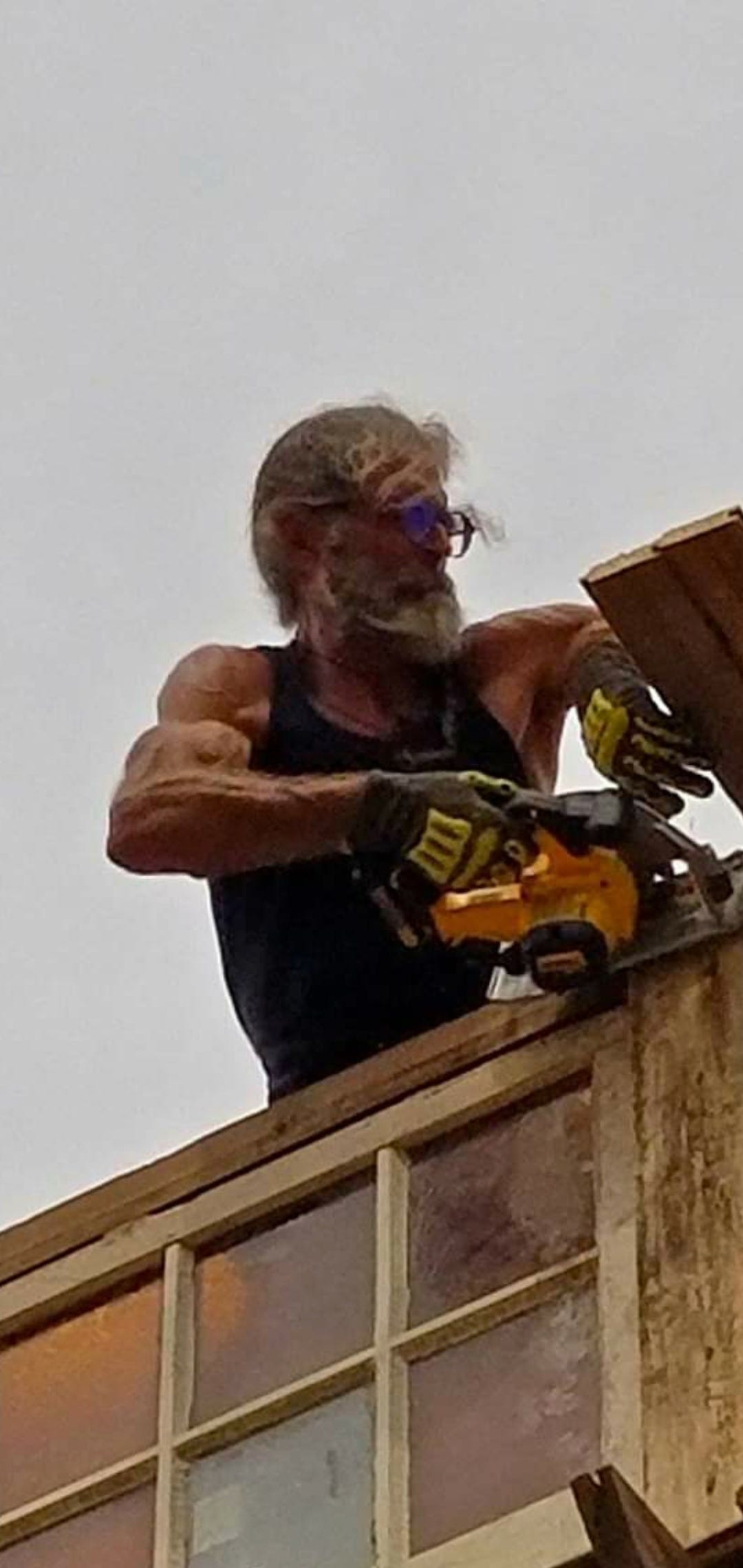
Surprisingly, there is a potential for huge amounts of income to be generated and folded back into the TTH Outpost Community several times. It has the unique feature, unlike most industries, to keep returning the income it generates in the form of payroll, that buys houses, which in turn rolls back into the Outpost community for several more cycles because it will include entire families that work on all of the various projects. This is better than exports or service jobs for corporations or franchises that bleed much of the profit away from the people and communities that are doing the bulk of the work.
Self-employed people tend to work harder and pay for their own way faster than employees who feel dependent on the system, their employer, or the government to bail them out of hard times. This is a way that they can personally help change the direction of the world’s consumption of resources for housing. It is also a way for people to get involved in solving the needs of their local community which gives people a sense of accomplishment and comradeship that cannot be given or bought. It creates an opportunity for the resurgence of closer families and neighbors bonding together in ways that make the whole community stronger.

The cycle of Salvage Mining to Salvage Building creates a place for everyone to work if they want to participate. Some people will be great nail pullers and others, great builders. How the proceeds and benefits get divided will be important to the sense of community that results, but it should create nearly universal success if the motives of the people involved are positively channeled under a common cause.

It will be important that the people do not feel alone as independent entrepreneurs but rather feel like part of a big community that benefits from each of its member’s success. The Pure Salvage Living Renaissance Family (PSL) will be a giant support network that interacts and shares the improvements and benefits of new ideas that develop over the course of working in various regions with different building materials, ideas, and climates.

Regional and national seminars, conventions, and other management tools will aid in trying to keep the PSL family united, motivated, and working with a common standard and vision. Such events will give us the opportunity to recognize people who excel and ideas that can be shared. Likewise, we can create financing programs for members, sponsor seminar training, and support a viable mechanism for salvage jobs to be dispatched by the Salvage Foundation to certified regional Salvage Hunters and Salvage Miners. The benefits of being part of the TTH family will also help cement together the communities that will appreciate the opportunity and provide the support it takes to be self-employed.
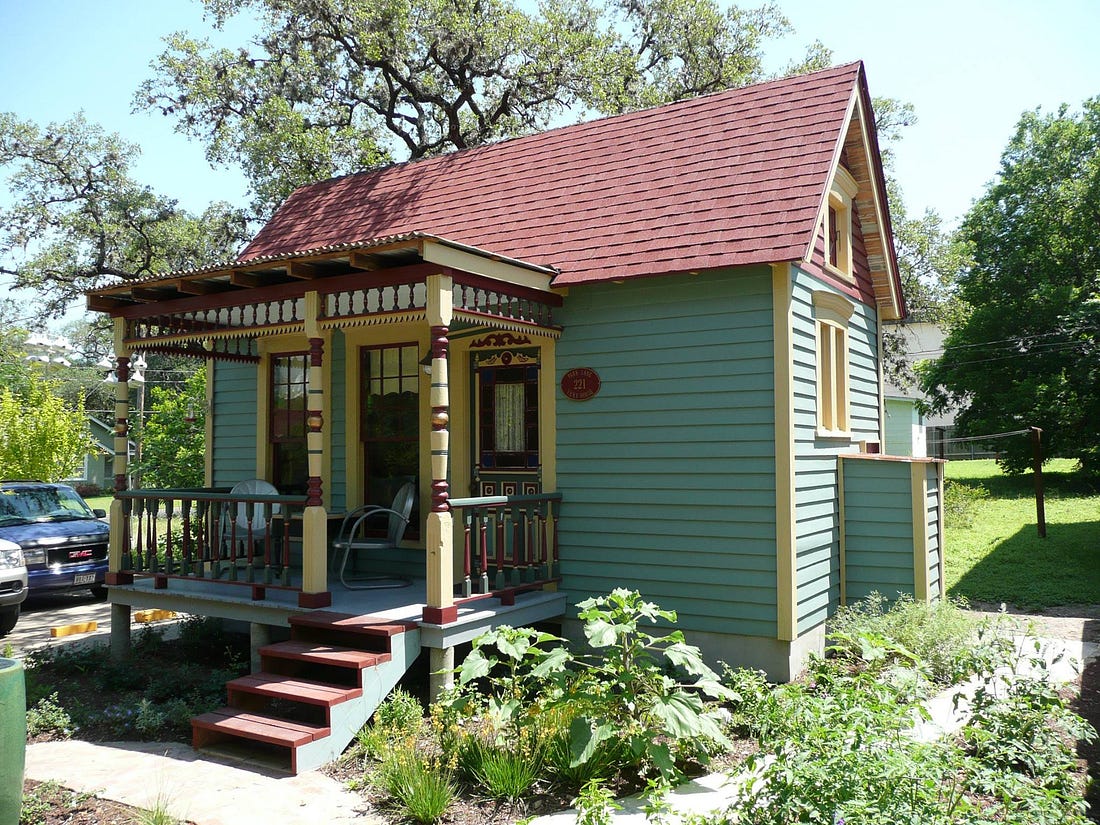
Just like the Tiny Texas Houses, where we don’t try to create exactly the same house twice, we aren’t going to try to create exact copies of the Outposts or Villages but instead, we expect to relish the diversity because of the ideas and solutions that will be generated for regional problems that arise. Tiny Texas Outposts and Pure Salvage Living Villages are intended to each be different from the other, but hopefully, all formed with the same common modules and the goal of making a difference on a global scale, one house at a time, one life at a time, and one community at a time.

It is not what you have, but what you do with it that determines your legacy.
If I can teach a man how to build a house from salvage then his family will never need a home.
The workers are available and unemployed, buildings empty and unused, and equipment sitting idle and for sale cheap. We just need to supply them with a new industry: Salvage is the solution.
Please share, consider how to help if you can, and let me know if I can help you get started too. The Pure Salvage Living Renaissance is about sharing, caring, teaching others how to thrive with all the treasures still full of life… like your elders and wonders you have yet to see.
Darby Lettick
